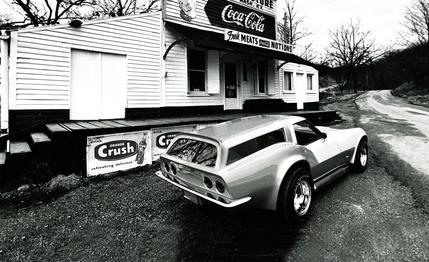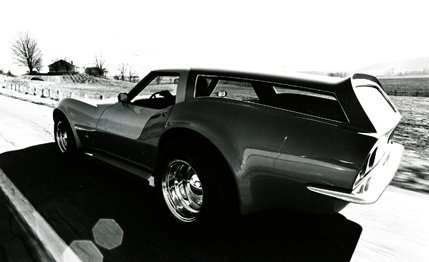
 Archived Road Test
Archived Road Test
The Corvette is the epitome of the "big on the outside, small on the inside" school of sports car design. In comparison to its peers, its exterior dimensions are gigantic. It is 18 inches longer than a Porsche, and over a foot longer than a Pantera or a 350 SL. And the massive styling of the Stingray's rear would make you think the trunk, hiding under all that fiberglass, must be the size of a backyard swimming pool. It isn't. In fact, there is no trunk. What's back there is almost all gas tank, spare tire and suspension components. The only storage space is the small alcove behind the two seats, a space strained to accommodate a spare set of spark plugs—and the wrench you have to leave at home.
Consequently, ever since the Stingray body was introduced five years ago, there has been a loud demand for a modification to provide room enough to get in the luggage that necessarily accompanies even two passengers.


The waiting is over. The Corvette Sportwagon is here. In the January issue we previewed some of the sport coupes we would like to see transformed into sportwagons in the manner Volvo breathed new life into the 1800E. Among our ideas was a Corvette with a Monza GT-type rear window, and a Lamborghini Espada glass panel above the taillights. In point of fact, the car as shown was still more of a coupe than a wagon; we had merely replaced the tunnel roof with a conventional fastback.
To really be useful, the Corvette demands more radical plastic surgery to make it a sportwagon. And that is what you see here. It’s not a station wagon with a tall and tippy box at the back, but neither is it a truncated sport coupe with no room at all. It doesn't have seating for nine, room for the proverbial 4x8 of plywood, nor does it look like something to be painted schoolbus yellow and have flashing lights on the roof. This sport-wagon is a sports car first, and a wagon second. And that's the way it should be. We have tried ourselves to make a sports car out of both wagons and vans, and we know from experience that if you want a true sportwagon, you have to start with the sport and add the wagon, rather than the other way around.


Of course, the ideal way for this to happen is for your sportwagon to be designed that way from the outset. But the world's manufacturers aren't yet up to that point. Until that situation changes, a wagon roof will remain a custom add-on accessory—for those with a lot of time, a lot of money, or both.
Harry Bradley is a freelance California designer, and a professor at the Art Center School in Los Angeles. His particular specialty is designing custom cars for those who do have a lot of time and money to spend.
Concurrent with our design, Bradley was working on an improved version. He decided to update the Corvette styling by using a roof similar to that on the Vega Kammback, complete with spoiler—perhaps the most current of Chevrolet's offerings in terms of design. In other words, Bradley was merely doing what the factory could have done—updated the Corvette into a practical car without losing any performance or appearance.